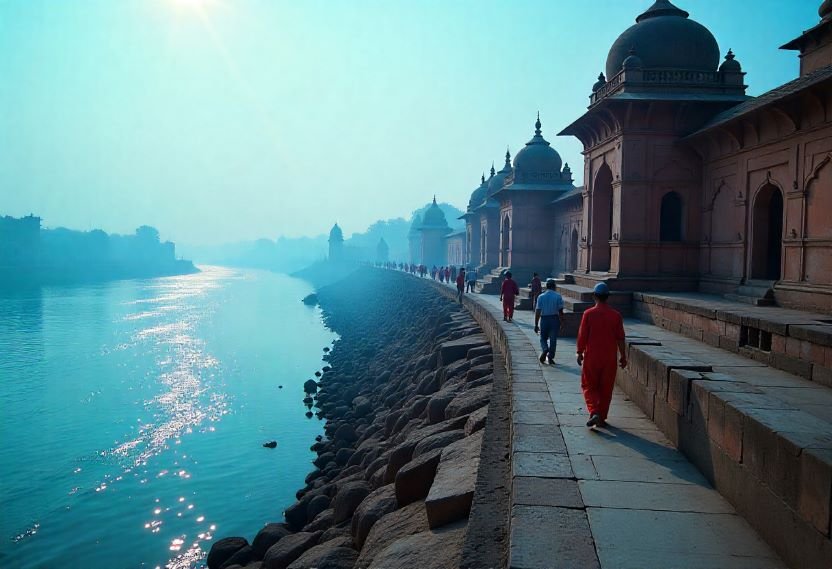Spiritual Travel
Indian Railway Catering And Tourism Corporation Leads The Charge In Mizoram’s Tourism Evolution With Unstoppable Focus On Eco And Spiritual Journeys

Saturday, May 24, 2025
IRCTC partners with Mizoram to boost eco and spiritual tourism, enhancing global visibility and sustainable travel while fostering cultural and natural preservation.
The Indian Railway Catering and Tourism Corporation (IRCTC) is preparing to sign a Memorandum of Understanding (MoU) with the Mizoram Tourism Department next week, a strategic partnership aimed at boosting eco-tourism and spiritual travel, while strengthening travel connectivity in Northeast India. This collaboration is expected to provide a significant uplift to Mizoram’s tourism sector, enhancing its appeal as an eco-friendly and culturally rich destination for both domestic and international visitors.
IRCTC, a public sector undertaking under the Ministry of Railways, has been pivotal in promoting tourism across India since its inception in 1999. As a Navratna enterprise, IRCTC provides a variety of services including ticketing, catering, and tourism management. The upcoming MoU with Mizoram reflects the company’s growing emphasis on sustainable tourism, highlighting its commitment to promoting responsible travel practices while also preserving the natural and cultural integrity of the regions it serves.
Mizoram, known for its rolling hills, vibrant indigenous culture, and diverse ecosystems, is a largely untapped destination for eco-tourism. The state’s rich flora and fauna, combined with its peaceful ambiance, make it an ideal destination for travelers seeking a serene getaway in the lap of nature. By partnering with IRCTC, the state hopes to attract eco-tourists and cultural travelers alike, who are keen on experiencing not just the landscapes but also the deep-rooted traditions that make Mizoram unique.
Under the terms of the MoU, IRCTC will take the lead in promoting the state’s tourism offerings by launching a series of tailored travel packages. These packages will cater to a wide range of tourists, offering everything from short excursions to extended stays. The tourism department aims to showcase Mizoram as an eco-tourism hub, with a strong emphasis on sustainability and conservation. The state’s government has also promised to focus on minimizing the environmental impact of tourism, ensuring that it benefits both the local economy and the surrounding environment.
IRCTC will also open up opportunities for outbound travel for the people of Mizoram. The partnership is set to offer Mizoram residents travel options to a variety of international destinations, including Nepal, Bhutan, Thailand, Singapore, Malaysia, Vietnam, and several countries in Europe. This facet of the MoU aims to create a balanced flow of tourism, allowing both inbound tourists to experience Mizoram and Mizoram residents to explore new international frontiers.
In addition to eco-tourism, the partnership will strengthen the state’s offerings in the realm of spiritual tourism. As part of its growing focus on this niche sector, IRCTC recently organized a successful pilot Christian pilgrimage tour for a group of pastors from Mizoram. The tour took participants to key biblical landmarks, including Corinth, Thessaloniki, Athens, and Patmos in Greece, as well as Rome in Italy. The success of this initiative has encouraged IRCTC to continue expanding its spiritual tourism offerings, with plans to organize similar pilgrimage tours for other groups in the future.
The MoU is expected to play a critical role in driving economic growth for Mizoram, particularly by promoting sustainable tourism practices that help preserve the state’s unique environment and cultural assets. The focus on responsible tourism is aligned with global trends that prioritize eco-friendly travel and community-based tourism, which can help generate jobs, foster local entrepreneurship, and boost the region’s overall economic development.
In addition to the economic benefits, the partnership aims to strengthen the social fabric of the region by promoting inclusive development. As tourism grows, the local communities stand to gain from the increased demand for hospitality services, transportation, and local crafts. This will, in turn, offer new livelihood opportunities to Mizoram’s rural populations, who have traditionally relied on agriculture and forest resources.
Since its establishment, IRCTC has played a pivotal role in shaping the tourism landscape in India, and this latest collaboration with Mizoram is seen as a natural extension of its vision to create sustainable, inclusive tourism experiences across the country. By focusing on Mizoram’s eco-tourism potential and cultural heritage, IRCTC is helping to spotlight a lesser-known gem in India’s Northeast, which has immense untapped tourism potential.
This MoU is not just about tourism; it’s about fostering a long-term, mutually beneficial relationship between IRCTC and the Mizoram Tourism Department. Together, they hope to transform the state into a leading destination for both eco-tourism and spiritual tourism, marking a significant milestone in the evolution of Northeast India’s tourism sector.
With both organizations working towards promoting sustainable tourism practices and inclusive development, this partnership could set a benchmark for future collaborations between the public and private sectors in India’s tourism industry.
Spiritual Travel
Saudi Arabia sets record with 140k flights during Hajj 2025

Saudi Arabia set new records for air traffic during the Hajj 1446 AH (2025), managing over 140,000 domestic and international flights. This figure marked an 8% increase compared to the previous year, showcasing the Kingdom’s growing capability in handling large-scale religious travel. The successful movement of millions of pilgrims by air highlights Saudi Arabia’s strong logistics network, use of advanced technologies, and efficient coordination between airports and air navigation teams. This achievement reinforces the country’s role as a key player in global religious tourism.
The arrival and departure phases were handled with excellent precision. During the arrival phase, from Dhu Al-Qidah 1 to Dhu Al-Hijjah 8, a total of 74,902 flights were recorded—a 15% rise from last year. The departure phase, from Dhu Al-Hijjah 23 to Muharram 15, saw 66,072 flights, a 2% increase. On Dhu Al-Hijjah 2, the Kingdom recorded its highest single-day aircraft movements with 2,338 flights. These milestones reflect strong planning and readiness for peak travel seasons.
A total of 213 airlines participated in the Hajj 2025 season, significantly enhancing global connectivity. This shows Saudi Arabia’s importance as a central hub for Muslim pilgrims worldwide. Pilgrims from various continents accessed the Kingdom smoothly, benefiting from improved air services and facilities. The increase in airline participation highlights Saudi Arabia’s rising global reputation in aviation, particularly in supporting international religious travel through expanded air corridors and partnerships.
The Saudi Air Navigation Services (SANS) organisation played a critical role in this success. They deployed advanced air traffic management technologies and highly skilled professionals to ensure safe and smooth air operations. Engineers, controllers, and maintenance staff worked continuously to manage the high traffic volumes without delays. The effective use of technical infrastructure helped maintain safety standards, improve efficiency, and enhance the overall travel experience for millions of pilgrims at major airports.
Saudi Arabia’s success during Hajj 2025 shows that it is ready for future growth in religious tourism. Through strategic planning, modern technologies, and a focus on global partnerships, the Kingdom is setting new benchmarks for managing large-scale international travel. Its efforts not only support smooth pilgrim journeys but also strengthen its image as a global aviation and spiritual hub. This performance underlines the country’s commitment to safe, well-organised, and spiritually enriching experiences for all visitors.
Spiritual Travel
6 Indian cities where Lord Krishna’s divine presence still lives on

1.Mathura
Mathura, revered as the birthplace of Lord Krishna, holds immense spiritual significance in Hinduism. The Krishna Janmabhoomi Temple stands at the exact spot where he is believed to have been born in a prison cell. The atmosphere of the city is steeped in devotion, especially during Janmashtami, when thousands of devotees gather to relive the divine birth through rituals, music, and processions. Every corner of this ancient city echoes tales from Krishna’s early life.
Spiritual Travel
Uttar Pradesh Revitalizes Religious Tourism with Nine Crore Rupees Investment in Lucknow’s Temples and Riverfronts

Wednesday, August 6, 2025
As part of broader efforts to develop the tourism potential of the state, the Uttar Pradesh Tourism Department has sanctioned ₹9 crore funding to restore important religious and cultural sites in Lucknow. Famous temples and the riverfront areas on the Gomti River, considered the heart of the city, will be enhanced as part of this project which received approval in August 2025. This is likely to enhance religious tourism in Lucknow and enrich the experience for domestic and overseas tourists visiting some of the city’s cherished spiritual sites.
Key Projects Under the ₹9 Crore Plan
The development scheme comprises ten projects which enhances the religious and cultural tourism archetypes in Lucknow. The government of Uttar Pradesh has set aside some funds for the restoration and repairs of some important temples and also for the development of the riverfronts to facilitate more pilgrims and tourists. Some of the important projects are:
- Sheetla Mata Temple, Kakori: ₹1 crore has been set aside for restoration work on the Goddess Sheetla temple which is an important temple for the local devotees.
- Koneshwar Mahadev Temple, Chowk: Another ₹1 crore has been allocated for the servicing of the ancient Shiva temple which is visited by a large number of people paying their respects to Lord Shiva.
- Shiv Temple, Karheta (Ambedkar Nagar Ward):₹1 crore has been assigned for the restauration of the historic temple which is a known for being a spiritually appealing tourist site.
- Kalika Devi Temple, Amlauli Village: The Kalika Devi temple which is popularly worshipped by many people will be provided with ₹1 crore to be used towards the renovation and modernization works to better serve the devotees.
- Shri Hanuman Temple, Athnaru (Sukhmadatt Nagar): The Shri Hanuman Temple, which is a major worship place for many people will also have ₹1 crore allocated for its restoration.
- Shri Mahadev Jalsai Nath Temple: This temple will receive ₹1 crore earmarked for the enhancement of its development which will add to the spiritual services provided in the city.
- Shri Jwala Mata Temple, Barigwan: ₹50 lakh is to be provided for the enhancement works to the important temple of Goddess Jwala Mata which will improve the religious tourism in the area.
- Sanjhiya Ghat, Gomti River: ₹1 crore will be spent on the development of Sanjhiya Ghat on the Gomti River, an area visited by people for spiritual and ceremonial activities and offering some of the services.
- Shri Ram Janki Temple: The Shri Ram Janki Temple is receiving ₹1 crore for further development on the infrastructure. The shrine is uniquely positioned in such a way that shrines of both Rama and Janki can be visited.
- Ghatghata Baba Devsthan, Salehnagar Village: ₹50 lakh has been allocated for this temple, which holds deep significance for locals.
Alongside safeguarding the spiritual legacy, these initiatives seek to improve the overall experience for visitors. Aside from reconstruction of the ancient temples, the state government also aims to implement a sustainable model that boosts tourism while honoring the site’s cultural and religious values.
Improvement Plans for Visitor Facilities
As part of these temple restorations, the Government of Uttar Pradesh allocated significantly within the ₹9 crore budget towards developing the infrstruture of these religious sites. The upgrades will help in making the sites easier and more pleasant to access for travelers. The major upgrades include:
- Lighting Installations: To illuminate the temples and surrounding areas, improving the visual appeal and providing greater accessibility during evening hours.
- Sanitation and Hygiene Facilities: Ensuring that visitors have access to clean and well-maintained restroom facilities, which is crucial for sustaining the increasing foot traffic in these religious sites.
- Drinking Water Stations: To ensure the comfort and convenience of visitors, water stations will be installed at key locations to meet the needs of the increasing number of tourists.
- Pathway Development: New pathways will be constructed around the temples and riverfronts, making it easier for visitors to access the sites.
- Tourist Information Centers: These centers will be set up to offer guidance and information about the historical and spiritual significance of the temples, enhancing the overall visitor experience.
Promoting Religious Tourism as a Key Economic Driver
The ₹9 crores tourism development plan for UP is intended for religious tourism which is important for the state’s economic development. UP’s infrastructure for tourism is expected to improve which will enhance economic development for the state. Improvement of infrastructure will allow better access to important spiritual site to enhance the number of visitors and help with economic development. Improvement of sites will also assist in providing employment and preserving cultural and local businesses.
Additionally, the plan aligns with Uttar Pradesh’s ongoing commitment to preserving its rich religious and cultural heritage. The state has long been a hub for spiritual tourism, and with the proposed upgrades, it is positioning itself to become an even more attractive destination for pilgrims and tourists alike.
Conclusion: A Bright Future for Religious Tourism in Lucknow
Uttar Pradesh’s spending on restoring and building religious tourism sites signifies an important move towards augmenting the cultural heritage of the region while improving the experience for tourists. The investment will make certain that the sacred sites continue to evoke and attract pilgrims for years to come. The initial development of Lucknow’s spiritual landmarks will further aid the growth of tourism and create sustainable and enriching experiences for visitors from different parts of the globe. The state is also investing ₹9 crores for the initial development of Lucknow’s spiritual landmarks.
The restoration of Lucknow’s temples and riverfronts are set to boost the city’s tourism greatly. They will not only capture the attention of tourists whose interests lie in spirituality but will also attract culture enthusiasts. This is one of the few times when tourists can easily access the core of the ancient spiritual heritage in the state of Uttar Pradesh.
-

 Brand Stories2 weeks ago
Brand Stories2 weeks agoBloom Hotels: A Modern Vision of Hospitality Redefining Travel
-

 Brand Stories2 weeks ago
Brand Stories2 weeks agoCheQin.ai sets a new standard for hotel booking with its AI capabilities: empowering travellers to bargain, choose the best, and book with clarity.
-

 Destinations & Things To Do3 weeks ago
Destinations & Things To Do3 weeks agoUntouched Destinations: Stunning Hidden Gems You Must Visit
-

 Destinations & Things To Do2 weeks ago
Destinations & Things To Do2 weeks agoThis Hidden Beach in India Glows at Night-But Only in One Secret Season
-

 AI in Travel3 weeks ago
AI in Travel3 weeks agoAI Travel Revolution: Must-Have Guide to the Best Experience
-

 Brand Stories1 month ago
Brand Stories1 month agoVoice AI Startup ElevenLabs Plans to Add Hubs Around the World
-

 Brand Stories4 weeks ago
Brand Stories4 weeks agoHow Elon Musk’s rogue Grok chatbot became a cautionary AI tale
-

 Brand Stories2 weeks ago
Brand Stories2 weeks agoContactless Hospitality: Why Remote Management Technology Is Key to Seamless Guest Experiences
-

 Asia Travel Pulse1 month ago
Asia Travel Pulse1 month agoLooking For Adventure In Asia? Here Are 7 Epic Destinations You Need To Experience At Least Once – Zee News
-

 AI in Travel1 month ago
AI in Travel1 month ago‘Will AI take my job?’ A trip to a Beijing fortune-telling bar to see what lies ahead | China












